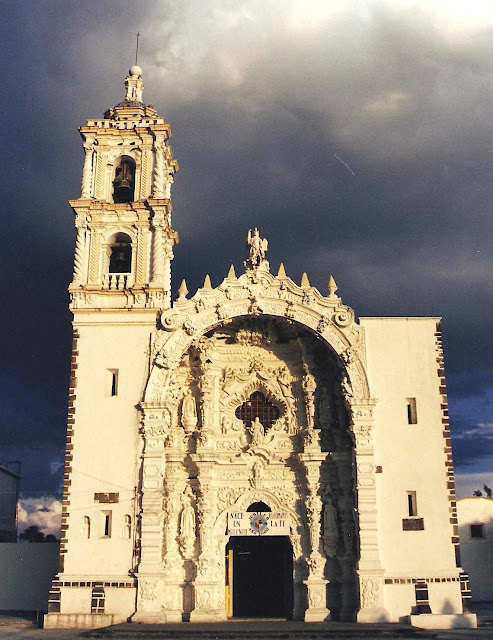 |
| San Nicolas Panotla, facade © Felipe Falcón |
The sumptuous baroque temple at Panotla, dedicated to St. Nicholas of Bari, is located a few kilometers west of the city of Tlaxcala. It displays an opulent stone and stucco facade reminiscent of the nearby shrine to the Virgin of Ocotlán.
 |
| The Panotla cross, author's reconstruction |
The Atrium Cross
Today this handsome colonial cross is missing. Only the inscribed base is still in place. Based on early photographs, this archaic stone cross, with its stubby arms and neck, was quite unlike others in the Tlaxcala region.
The primitive Face of Christ at the crossing resembled that of a Pharoah, with spreading locks and a zigzag Crown. In part because of their odd shape and position as well as their eroded state, several of the numerous Passion reliefs on the arms and long shaft were ambiguous. Two relief Nails with four pierced rosettes flanked the Face. Above Christ’s head, a band of wavy lines, possibly indicating Coins, crosses the neck below a more complex, sunburst style rosette set with outlying buds or points—perhaps also intended as a Crown. However, another stylized, wreathlike Crown was juxtaposed beside a Chalice atop the shaft, below which an enigmatic figure appeared apparently bearing a cross—a unique in- stance of this motif, if our interpretion is correct.
Further down, a fan of three Nails, a Hammer, a Scourge and diminutive crossed Spear and Reed led to an open Hand beside a Column and Rooster, ending with a Ewer at the foot.
 |
| THE CROSS PEDESTAL TODAY © Niccolo Brooker |
text and graphic © 2018 Richard D. Perry
No comments:
Post a Comment